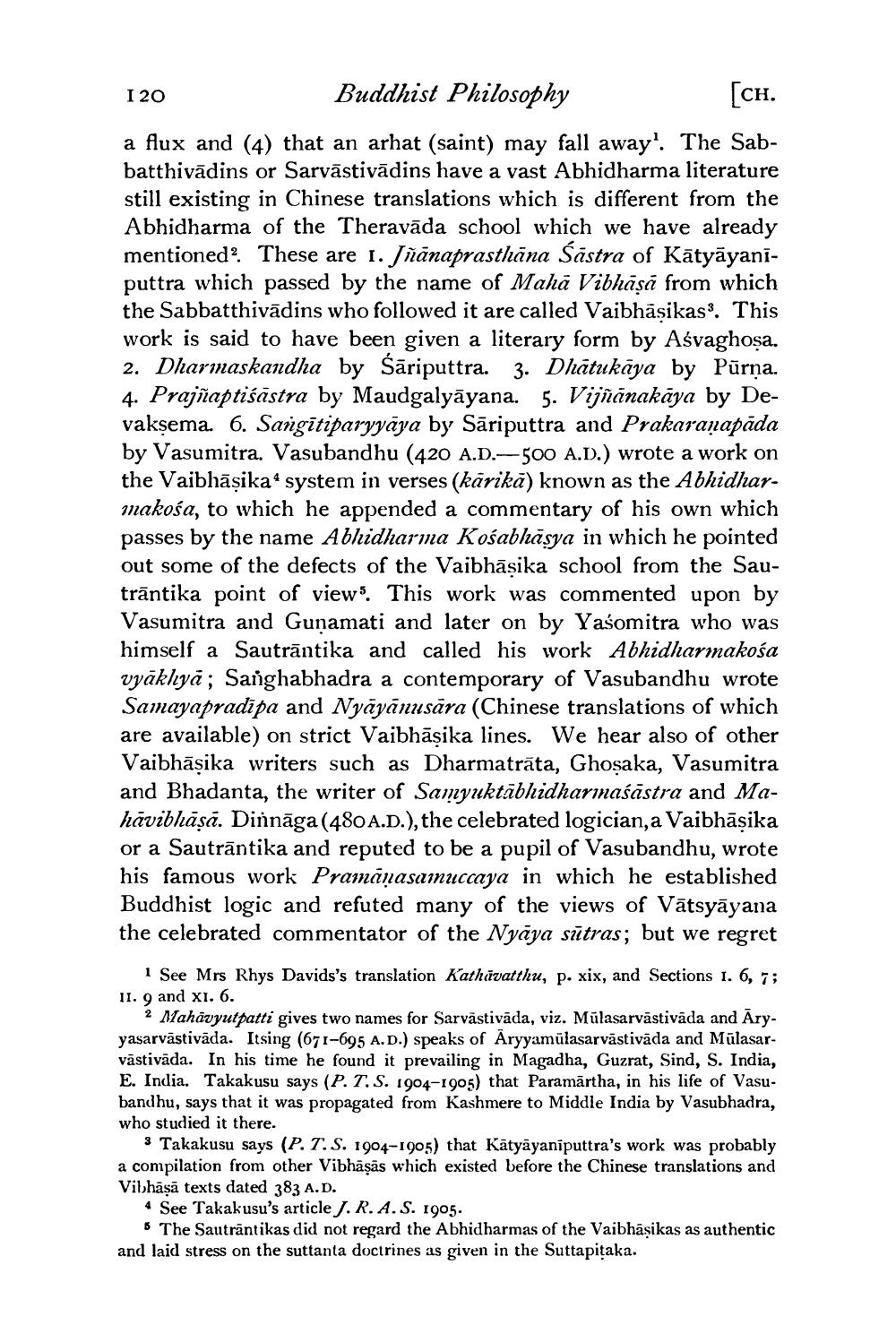________________
I 20
Buddhist Philosophy
[ch.
a flux and (4) that an arhat (saint) may fall away? The Sabbatthivādins or Sarvāstivādins have a vast Abhidharma literature still existing in Chinese translations which is different from the Abhidharma of the Theravāda school which we have already mentioned? These are 1. Jñānaprasthāna Šāstra of Kātyāyaniputtra which passed by the name of Mahā Vibhāsā from which the Sabbatthivādins who followed it are called Vaibhāşikas. This work is said to have been given a literary form by Aśvaghosa. 2. Dharmaskandha by Sāriputtra. 3. Dhātukāya by Pūrņa. 4. Prajñaptiśāstra by Maudgalyāyana. 5. Vijñānakāya by Devaksema. 6. Sangītiparyyāya by Sāriputtra and Prakaranapada by Vasumitra. Vasubandhu (420 A.D.-500 A.D.) wrote a work on the Vaibhāșika“ system in verses (kārikā) known as the Abhidharmakośa, to which he appended a commentary of his own which passes by the name Abhidharma Kośabhāsya in which he pointed out some of the defects of the Vaibhāșika school from the Sautrāntika point of views. This work was commented upon by Vasumitra and Gunamati and later on by Yaśomitra who was himself a Sautrāntika and called his work Abhidharmakosa vyāklıyā; Sanghabhadra a contemporary of Vasubandhu wrote Samayapradīpa and Nyāyānusāra (Chinese translations of which are available) on strict Vaibhāșika lines. We hear also of other Vaibhāșika writers such as Dharmatrāta, Ghosaka, Vasumitra and Bhadanta, the writer of Samyuktābhidharmaśāstra and Mahāvibhāsā. Dinnāga (480 A.D.), the celebrated logician, a Vaibhāsika or a Sautrāntika and reputed to be a pupil of Vasubandhu, wrote his famous work Pramanasainuccaya in which he established Buddhist logic and refuted many of the views of Vātsyāyana the celebrated commentator of the Nyaya sūtras; but we regret
1 See Mrs Rhys Davids's translation Kathāvatthu, p. xix, and Sections 1. 6, 7; 11. 9 and xi. 6.
2 Mahāvyutpatti gives two names for Sarvāstivāda, viz. Mülasarvāstivāda and Aryyasarvāstivāda. Itsing (671-695 A.D.) speaks of Aryyamūlasarvāstivāda and Mülasarvāstivāda. In his time he found it prevailing in Magadha, Guzrat, Sind, S. India, E. India. Takakusu says (P.T.S. 1904-1905) that Paramartha, in his life of Vasubandhu, says that it was propagated from Kashmere to Middle India by Vasubhadra, who studied it there.
3 Takakusu says (P. T. S. 1904-1905) that Katyāyaniputtra's work was probably a compilation from other Vibhāṣās which existed before the Chinese translations and Vibhāṣā texts dated 383 A.D. 4 See Takakusu's article J.R.A.S. 1905.
The Sautrāntikas did not regard the Abhidharmas of the Vaibhāsikas as authentic and laid stress on the suttanta doctrines as given in the Suttapitaka.




